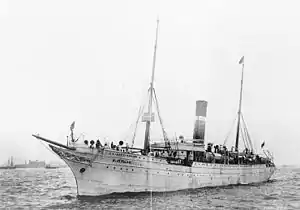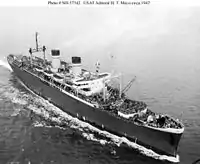Army Transport Service
The United States Army Transport Service (ATS) operated Army transport ships for both troop transport and cargo service between United States ports and overseas posts.[1] This service is often confused with the Army Transportation Service, created in France in 1917 to manage American Expeditionary Forces transport, renamed Transportation Corps 12 November 1918 still limited to France, becoming a general service under the Quartermaster Corps responsible for land and water transport, then briefly a name applied to a larger organization in the early days of World War II, and becoming the separate Transportation Corps effective 31 July 1942.[2]

The Army Transport Service was established when the Army's difficulty in transporting its forces was exposed in the Spanish–American War with formal establishment in the fall of 1898 to operate under the Quartermaster Corps. ATS operated the Army's large ships but did not operate smaller vessels of the harbor boat service (tugs, launches, small and short range supply boats), the mine planters of the Coast Artillery Corps or any vessels of the Corps of Engineers. From that time until absorbed into the United States Army Transportation Corps to operate under its Water Division the service operated the United States Army Transports. Except during World War I, when the Army's large transports were turned over to the Naval Overseas Transportation Service (NOTS), ATS operated the sometimes sizable fleet of Army transports.[3]
During peacetime ATS was to operate directly under the Quartermaster General through a General superintendent at home ports and in wartime, when formal ports of embarkation were to be established, ATS would come under the port commander's jurisdiction.[4] During the interwar period ATS Atlantic was based at the New York General Depot, Army Supply Base, in Brooklyn and ATS Pacific and the transport docks were at the San Francisco General Depot, Fort Mason, California.[5] The Army considered maintenance of a nucleus of military personnel, intimately familiar with both military requirements, port and ship operations, that could form the core of a full port of embarkation staff in wartime or other emergency as one of the reasons for maintaining ATS itself.[6] Coordination with other Army transport functions was aided by the fact ATS was one of the four interwar divisions of the Army Transportation Service which also had divisions responsible for rail, motor and animal transport.[7]
ATS itself became the Water Division of the Transportation Corps but the Army Transport Service name continued to be applied to the large ship branch of that division.[8] The vessels themselves were commanded by civilian merchant mariners with a civilian crew. The large troop transports had military representatives or the Quartermaster or Transportation Corps aboard that were designated as transport commanders, on larger vessels with extended staff, with authority over all embarked personnel but no authority over the ship itself. On smaller vessels or cargo ships a single officer would represent the Corps. The ships were not armed except during wartime when naval type guns were installed.[9][10] During World War II the guns were manned by Naval Armed Guard gun crews. Naval personnel, either Armed Guard or communications were under their own commander independent of ship's master or Corps representatives in tactical matters.[11]

After World War II the Army's large transports resumed peacetime operation for a brief time until the formation of the Department of Defense resulted in consolidation under the Navy's Military Sea Transportation Service.
References
- Clay 2011, pp. 2135–2138.
- Wardlow 1999, pp. 28–55.
- Clay 2011, pp. 2126, 2135–2138.
- Special Regulations No. 71. 1918, p. 11.
- Army List and Directory: Depots of the Zone of the Interior.
- United States Congress, Hearings, 1921, p. 10.
- United States Congress, Hearings, 1921, p. 15.
- Wardlow 1999, pp. 243, 270.
- Lohrer, George L. Ordnance Supply Manual, U. S. Ordnance Dept., 1904, pp. 282-295
- Gun and Carriage cards, National Archives and Records Administration, Record Group 156, Records of the Chief of Ordnance, Entry 712
- War Department 1944.
Bibliography
- Clay, Steven E. (2011). U. S. Army Order Of Battle 1919-1941 (PDF). Volume 4. The Services: Quartermaster, Medical, Military Police, Signal Corps, Chemical Warfare, And Miscellaneous Organizations, 1919-41. 4. Fort Leavenworth, KS 66027: Combat Studies Institute Press. ISBN 9780984190140. LCCN 2010022326.CS1 maint: location (link) CS1 maint: ref=harv (link)
- War Department (1918). Special Regulations No. 71: Army Transport Service. War Department Regulation. Washington, DC: United States Department of War. Retrieved 23 November 2014.
- War Department (1944). FM55-10 Water Transportation: Oceanging Vessels (PDF). War Department Field Manual. Washington, DC: United States Department of War. Retrieved 23 November 2014.CS1 maint: ref=harv (link)
- Wardlow, Chester (1999). The Technical Services—The Transportation Corps: Responsibilities, Organization, and Operations (PDF). United States Army In World War II. Washington, DC: Center Of Military History, United States Army. LCCN 99490905.CS1 maint: ref=harv (link)
- United States Congress; House Committee on Merchant Marine and Fisheries (1921). Transport Service of the Government: Hearings Before the Committee on the Merchant Marine and Fisheries, House of Representatives, Sixty-Seventh Congress. Washington, DC: Government Printing Office.CS1 maint: multiple names: authors list (link)
- War Department (1929). Army List and Directory, January 1, 1929. Army List and Directory. Washington, DC: Government Printing Office.
External links
- With the Army at Hoboken (World War I description of operations at New York.)
- Army Quartermaster Corps—Army Transport Service (A.T.S.)
- Army - Transportation Service (U.S.) (Flags)